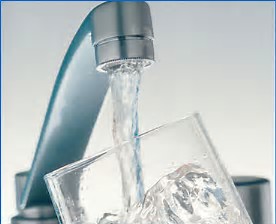|
Before You Take a Sip of Tap Water By Pierre Mouchette | Bits-n-Pieces If you want to taste clean, crisp, chemical-free water or learn how to avoid these harmful but common chemicals, we are here to help. The following tap water ingredients in your drinking water will surprise you.
Lead - One of the most notorious chemicals found in drinking water. A heavy metal, lead, is most present in public water systems. The amount of lead in the water depends on various factors, such as how long the water has been in the pipe network and how the corrosion affects the waterways. This corrosion can occur from poor upkeep and general wear and tear of waterway pipes. Though lead can expose you to harmful health effects, such as decreased kidney function, higher blood pressure, and reproductive problems, it is still a common chemical found in waterways that are older or not well-maintained. Even if you have a newer water system, it does not mean your water is lead-free. Chlorine - This is a chemical that is found chiefly in pools and cleaning supplies. However, chlorine in excess is not a chemical you want in your water. Chlorine is exceptionally harsh due to its sanitation properties and is added to water to purify it. However, exposure to too much chlorine, such as running baths, can dry out your skin. Though having a little chlorine in your water is generally safe and necessary against water-borne diseases, too much in excess may lead to trouble breathing, fatigue, and blurred vision, among other symptoms. Pathogens - Some treatments are added to our water to prevent pathogens like bacteria, diseases, and parasites. However, these sometimes dangerous forms can sneak into water supplies, especially those not adequately treated. Pathogens are common in private water cells since they do not receive the same treatment as public ones. Still, even in public water systems, if poorly maintained, it can cause contamination with sewage systems and even animal excrement. Nitrates - Commonly used as fertilizers for plants and greenery have nitrates. However, their extreme use makes them one of the most significant contaminants in public water systems. Nitrates are also naturally found in plants and soil at low levels, but their presence heightens when used as fertilizer. Due to factory farming, nitrates can slip into your water by runoff. Humans consume nitrates more often than they realize. For example, leafy greens and packaged meats commonly have nitrates present. There are still studies analyzing the effects of nitrates and their impact on the individuals who are exposed. However, some argue that nitrates can cause cancer or intestinal issues in humans who are overexposed. Fluoride - A typical chemical added to water to decrease tooth decay, Fluoride is recently rated as a harmful chemical. Most commonly, fluoride-free toothpaste increases as people speculate about fluoride and its long-term effects. Fluoride, in its chemical makeup, is a neurotoxin. According to a Harvard Study, fluoride is alongside lead and mercury as another chemical that can cause damage to the development of the brain if overexposed. Mercury - Is another heavy metal that is undesirable when present in drinking water. Not only is mercury associated with causing kidney damage, but it can get into the water by processes such as the earth’s natural crust degassing and fossil fuels or factory farms releasing mercury from runoff and industrial processes. Additionally, mercury is a neurotoxin that can affect a human in various ways. There are more ongoing studies to support the multiple issues mercury can cause, especially in the brain and organs. Arsenic - This is a harmful chemical found in drinking water that occurs naturally in rocks and soil. However, when present in water, arsenic is toxic if exposed long-term. Additionally, long-term exposure to arsenic in the form of drinking water can lead to the development of cancers of various organs, cardiovascular diseases, developmental issues in children, and respiratory issues. How to Keep You and Your Family Safe from What’s in Tap Water With the above chemicals, it is understandable if you are wary about tap water. However, you can take precautions to help ease the exposure and even eliminate it.
Peace of Mind Now that you know what is in tap water, you can take the proper precautions to ensure your family is safe from these harmful chemicals.
0 Comments
Your comment will be posted after it is approved.
Leave a Reply. |
Archives
May 2024
|
